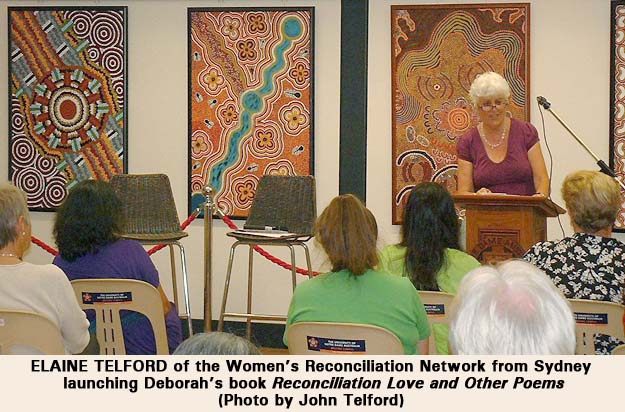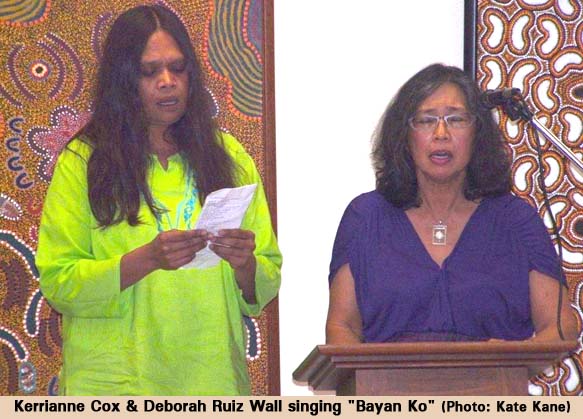
I would like to acknowledge our host, the Yawuru people in whose country we are conducting this event; the University of Notre Dame; Campus Librarian, Alicja Wieszczeczynska for her faith in me and her unassuming and creative approach to organizing this event; Campus Manager, Lyn Quince for making it possible; Deputy Vice Chancellor, Professor Lyn Henderson-Yates, who originally suggested that I stay at the university when I participated at the National Oral History Conference held at this university in 2008; Hostel Manager, Jennifer Tosch for her friendship and interest in what I am doing; Kevin Puertollano who was my gateway to the challenging work of doing oral history with the descendants of ‘Manilamen’ in Broome — a work in progress; Elaine Telford, one of the founders of the Women’s Reconciliation Network in Sydney who is here specially for the launch; Michelle Gregory and Panda Gardner, fellow readers of my new Broome poems; and Kerrianne Cox, who like Kevin has Filipino roots and who will be part of our storytelling tonight through song.
The Kimberley is not only an exceedingly beautiful place. Beyond that, it has many poignant stories that are inscribed on the landscape. Here in Broome lie many foundation stories of our emergence as people with diverse roots. Imagine new settlers like a graft to the ancient tree inheriting the story of place. As many of you know, I am currently here in Broome to do my PhD research fieldwork about how Aboriginal voices are heard and represented in the LNG hub development proposal at James Price Point.
What then am I doing here launching a photography exhibition and a poetry book in the middle of researching a contentious issue? Put another way, how do I negotiate around the boundaries of creative and intellectual pursuits?
The right brain might be distinct from the left but they are linked. Culture has many faces. We wear many cultural hats: the artistic, the managerial, the administrative, political, intellectual — corporate and business, and the list goes on. At bottom, Aboriginal people will say, is land and culture. Here in Broome, the word ‘Australian’ in fact springs from ancient Aboriginal, Asian and European ancestry. It springs from the reality and impact of Australia’s social engineering through the ‘Segregation and Protection’ policy, and it cannot be hidden. Shinju’s parade of the ‘Carnival of Nations’ attests to this collective co-existence we brand as ‘Australian’.
We have many languages. My photography and poetry is but one language that is engaged in trying to understand how we work our way to our sustainability, the sustainability of people and place realizing that we are all dwellers today within the same living space. Each culture has its own uniqueness, style of expression and unwritten rules but through time and evolution, the boundaries between cultures are by no means fixed. They are moveable like songline transactions between cultures. My verses, visual images, journal articles dance a dance that tries to find their inner connection, the inner threads, a dance that doesn’t have too prescribed a movement, a dance that respects each other’s uniqueness and character, a dance that is both exhilarating and challenging. To extend this dance metaphor, I ask: how does the local dance with the global? How does pristine culture dance with global energy demands? Each culture has its own space and language and governing rules. Each cultural landscape is storied. All our lives are storied. The beauty and colour of the Kimberley landscape have drawn in the tourism industry like a magnet. What holds this tantalizing attraction in a landscape that is so richly storied?
Tonight I offer you a form of storytelling in pictures, poetry and songs. Perhaps this moment may linger on after you leave this place tonight. Perhaps you will go away with another story for remembering.

Wind change
The wind blew in a different direction,
the Keeper of Culture’s Connection to country
blown away by a legal overlay.
Whose song is singing, whose law is reigning?
Walmadan, the Maban man must be wailing
in his grave, his waterhole will turn pindan
blood red, when ‘Mother Earth’ is slain
by the industrial machines’ smashing, crushing
clutches, and the sand dunes, the dark rocks jutting
by the shore, the blue waves that roll in the sea,
the frolicking and birthing marine dwellers
— humpback whales, turtles and dugongs
will sing no more…the locals will fish here
no longer, and their incredibly beautiful
ancient culture will be traded
for a moment’s illusory dream of ‘progress’.
Deborah Ruiz Wall, Broome, 2010
Bayan Ko
Ang bayan kong Pilipinas, lupain ng ginto't bulaklak,
pag-ibig ang sa kanyang palad nag-alay ng ganda't dilag.
At sa kanyang yumi at ganda, dayuhan ay nahalina.
Bayan ko, binihag ka nasadlak sa dusa.
Ibon mang may layang lumipad, Kulungin mo at umiiyak,
Bayan pa kayang sakdal dilag ang di magnasang makaalpas!
Pilipinas kong minumutya, pugad ng luha ko't dalita.
Aking adhika, makita kang sakdal laya!
Bayan Ko (My Country) was originally composed as a poem by Jose Corazon de Jesus in 1929 and set to music by Constancio de Guzman. It was written as a protest song during the American occupation of the Philippines.
My Country
My Country, the Philippines, land of gold and flowers,
love on the palm of her hand, an oblation of beauty and joy.
And her modesty and splendor allured the foreigner,
enslaved my country, threw her in distress.
For even a bird that is free to fly, if you cage it, it will cry.
So too for such a lovely country, would she not yearn to be free!
I revere my Philippines, cradle of my tears and despair,
my dream, is to see you truly free!

Further Reading:
 Home | Aims and Objectives of Solidarity Philippines Australia Network | About Kasama
Home | Aims and Objectives of Solidarity Philippines Australia Network | About Kasama 
Search the SPAN Web